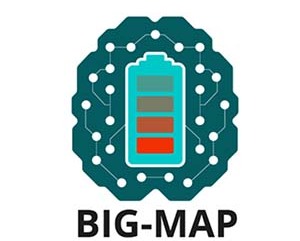BIG-MAP
The project:
The Battery Interface Genome – Materials Acceleration Platform (BIG-MAP) project is part of the large-scale and long-term European research initiative BATTERY 2030+. Here, we propose a radical paradigm shift in battery innovation, which will lead to a dramatic speed-up in the battery discovery and innovation time; reaching a 5-10 fold increase relative to the current rate of discovery within the next 5-10 years. BIG-MAP relies on the development of a unique R&D infrastructure and accelerated methodology that unites and integrates insights from leading experts, competences and data across the entire battery (discovery) value chain with Artificial Intelligence (AI), High Performance Computing (HPC), large-scale and high-throughput characterization and and autonomous synthesis robotics. In short, BIG-MAP aims to reinvent the way we invent batteries and to develop core modules and Key Demonstrators of a Materials Acceleration Platform specifically designed for accelerated discovery of battery materials and interfaces.
This will not be achievable in the three years of this project, but the BIG-MAP consortium has identified a set of Specific Objectives and 12 Key Demonstrators for the 3-year ramp-up phase that will develop and demonstrate the infrastructural backbone needed to achieve a 5-10 fold acceleration in the discovery process. In summary, the specific objectives are:
- Develop the scientific and technological building blocks and models for accelerated battery discovery
- Deliver cross-cutting initiatives to ensure implementation and use of project data and results across the battery discovery value chain
- Disseminate and reach the battery community throughout the battery value chain, to boost EU advanced battery development and manufacturing
CIDETEC’S role in the project:
Within BIG-MAP, CIDETEC will participate in:
- Manufacturing negative electrodes
- Carrying test campaigns to the cells to understand degradation mechanism including the tracking of SEI/CEI evolution
- Extending the multiphysics models – P4D- to ageing multiphysics models (implementing the mechanical/electrochemical degradation mechanism, including SEI/CEI evolution)
- Contributing in the implementation of Machine Learning algorithms for accelerate the understanding of the evolution of the SEI/CEI with testing conditions as well as formation steps.

Start: 01 | 09 | 2020
End: 31 | 08 | 2023
Budget: 20.000.000 €
The Technical University of Denmark (DTU) (coordinator)
Dassault Systèmes
BASF
CEA
Chalmers
CIDETEC Energy Storage
CNR-NANO
CNRS
ICMAB
EMIRI
EPFL
ESRF
Fraunhofer ISC
FZ Jülich
ILL
IT University of Copenhagen
KIT
NIC
PDT
Saft
SINTEF
Solvay
SOLEIL
TU Delft
University of Liverpool
Umicore
UNIVIE
University of Cambridge
University of Oxford
Uppsala University
Warsaw University of Technology
University of Münster
Financiator

This project has received funding from the European Union’s Horizon 2020 research and innovation programme under grant agreement No 957189.
Sectors
- Battery cell manufacturers
- Battery materials industry
Technological fields
- There are no technological fields












